 |
| December 06, 2016 | Volume 12 Issue 45 |
Designfax weekly eMagazine
Archives
Partners
Manufacturing Center
Product Spotlight
Modern Applications News
Metalworking Ideas For
Today's Job Shops
Tooling and Production
Strategies for large
metalworking plants
Wings:
Army researchers tackling tiny enemy -- sand
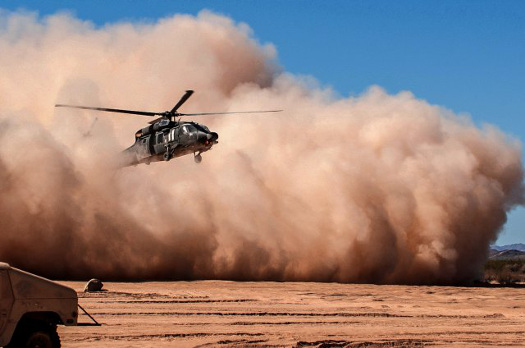
In austere environments with lots of sand and dust, Army aviators risk engine loss without a technology solution to protect their gas turbine engines. Army researchers are searching for a sandphobic coating. [Photo Credit: U.S. Army]
By David McNally, ARL
Armor offers reliable protection against external forces, but what if the enemy is so small that it can take aircraft down from the inside?
Sand and dust can significantly damage helicopter engines, which is why scientists and engineers at the Army Research Laboratory are experimenting with coatings in high-temperature environments with the goal of creating something -- anything -- that will cause sand to slide off the inside of a turbine engine the way an egg slides off a nonstick skillet.
"We are going through a very methodical process to understand the underpinning science and then use the science to predict the materials, what we call the engineered or tailored materials, that will lead to the right solution," explained Dr. Anindya Ghoshal, chief scientist for the laboratory's Vehicle Technology Directorate.
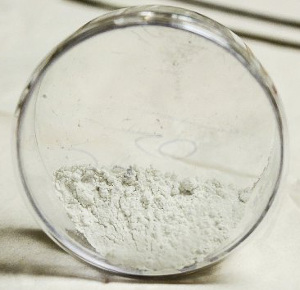
During brown-out conditions when a helicopter flies into a cloud of sand, micron-sized particles go through the turbine's combustor and adhere to the blades of the engine, restricting air flow and causing power loss. Army scientists use samples to discover a potential sandphobic coating for the inside of engines. [Photo Credit: David McNally]
Ghoshal leads the Army's efforts to develop what he calls "sandphobic" coatings. In regions like Southwest Asia, he said, Army forces frequently must contend with brown-out conditions, during which sand particulates and other dust particulates are ingested into the engines.
"Our goal is to have the particles strike the blades or vanes [inside a gas turbine engine] and then flake off," he said. "We want to understand the physical, chemical behavior. Once we can do that, then our idea is to take that model and then predict the type of material that would enable us to develop this sandphobic coating."
Helicopters already have filtration systems that attempt to filter out larger particles, but Ghoshal said micron-sized particles can pass through the turbine's combustor and adhere to the blades. This chokes the airflow and can lead to engine loss.
"We have a unique rig here," said Dr. Michael Walock, a physicist on the sandphobic coatings team. "The hot particulate ingestion rig allows us to shoot sand into the hot-gas flow at small level components and rapidly prototype new coating materials. With this system, we've done a world-first. We used high-speed imaging to confirm the molten state of the sand particles impacting onto these thermal barrier coatings."
Computer simulations are also helping researchers arrive at a technology solution.
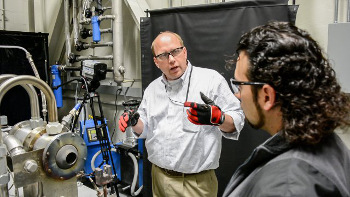
Army scientist Dr. Michael Walock (left) explains the operation of the U.S. Army Research Laboratory's hot particulate ingestion rig to ARL post-doctoral fellow Dr. Andy Nieto. [Photo Credit: David McNally]
"Computer modeling will play a big role in helping us to look at the interactions between particles and the surface," said Dr. Muthuvel Murugan, acting team lead for the lab's Turbomachinery Research Team. "The particles go through a phase change from solid to liquid and then they deposit onto the surface."
At the Army's Vehicle Research Laboratory, the team shot high-speed videos, revealing molten sand particles splattering on turbine blade material targets and then vaporizing -- a first in the scientific community.
"Computer modeling of this multi-physics complex phenomena will allow us to understand the damage mechanisms," Murugan said.
Murugan said they hope to use the power of supercomputers at the Department of Defense High Performance Computing Center also located at APG.
"We will use advanced computational fluid dynamics, together with particle ingestion, to better understand the interaction mechanisms of sand particles at a gas-turbine-engine-relevant high temperature," he said. "When we simulate how particles go through the flow-field and impact and adhere to the surface, then we can understand the vulnerable parts of the turbine blade and engineer a sandphobic coatings solution."
Sandphobic coatings research is part of a larger strategic effort the Army lab officials call the Science for Maneuver Campaign.
"With this campaign, we hope to discover, innovate, and transition science and technology-enabled capabilities that will significantly increase the force effectiveness and global responsiveness of the Army," said acting ARL Director Dr. Philip Perconti. "As we look to how we're going to enable the Army of the future, we see a need to discover technology solutions that will result in improvements in aviation responsiveness and the minimization of vulnerabilities."
Earlier this year, Ghoshal's team received DoD funding through the Laboratory University Collaboration Initiative, or LUCI, which means $600,000 over three years in collaboration with a National Security Science and Engineering Faculty fellow. Ghoshal is teaming with Dr. Jian Luo at the University of California San Diego.
"There is a close collaboration going on within the community to solve this problem," Ghoshal said.
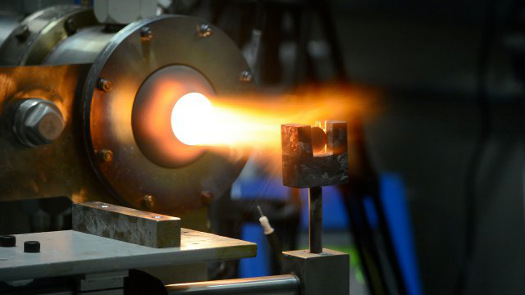
A hot particulate ingestion rig replicates temperatures inside a gas turbine engine, allowing Army scientists and engineers to shoot sand into a hot gas flow and experiment with different coatings solutions. [Photo Credit: David McNally]
Ghoshal is also working closely with other universities, industry, and government agencies, such as The Ohio State University; University of Connecticut; University of North Texas; Iowa State University; University of North Dakota; Boeing; the Army Aviation and Missile Research, Development and Engineering Center; the Air Force Research Laboratory; the Naval Air Systems Command; and NASA.
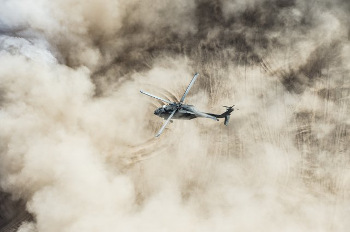
Besides the danger of low-visibility, sand and dust wreak havoc inside aircraft engines. As molten sand accumulates inside gas turbine engines, air flow is restricted caused loss of power. Army scientists and engineers are working to discover sandphobic coatings to save lives. [Photo Credit: U.S. Army]
In 2015, the team presented initial findings, "Turbomachinery Blade Thermomechanical Interface Science and Sandphobic Coatings Research," to the American Helicopter Society International 71st Annual Forum at Virginia Beach, VA. The paper received the "Best Paper Award in Propulsion Sessions" at the conference, Ghoshal said.
New research from the team will also be published in the January 2017 Advances in Aircraft and Spacecraft Sciences, an international journal.
"I strongly believe that, in the next three to five years, we will have not only one, but several solutions," Ghoshal said. "It will definitely save a lot of Soldiers' lives in the long run. Our solutions will make our Soldiers' lives safe and will make our Army stronger."
Published December 2016
Rate this article
View our terms of use and privacy policy
